Obama Administration Backs into Policy of Arming Syrian Rebels
James Phillips /
The White House announced yesterday that President Obama has authorized the transfer of arms to Syria’s rebels after concluding that Bashar al-Assad’s regime had violated the president’s red line against the use of chemical weapons.
The Obama Administration needed to reverse course and take stronger action in Syria to enforce the red line, or it risked emboldening the Assad regime to escalate its chemical attacks, as well as eroding the credibility of President Obama’s pledge to take action on Iran’s nuclear weapons program if diplomacy fails.
The Administration’s floundering policy has left it behind the curve on the intensifying crisis in Syria. It quickly abandoned the Bush Administration’s hard line against the Assad regime after coming into office and mistakenly viewed Assad as a reformer who should be courted diplomatically. After the Syrian “Arab Spring” protests broke out in March 2011, it lost time trying to engage the Assad regime and then outsourced U.S. policy to the United Nations, where Russia and China exercised their veto power to block effective action.
President Obama has over-promised and under-delivered in Syria. He called for Assad to step down in August 2011, but there was little follow-through when the Syrian dictator defiantly shrugged off that advice.
While the Administration offered humanitarian aid to Syrian refugees and later non-lethal aid for the Syrian opposition, it balked at providing arms. President Obama overruled the advice of CIA Director David Petraeus, Secretary of Defense Leon Panetta, Secretary of State Hillary Clinton, and the Chairman of the Joint Chiefs of Staff, General Martin Dempsey, to provide arms aid last year.
Now the arms aid offered may amount to too little too late. While the Administration engaged in wishful thinking about brokering an illusory political settlement, Russia and Iran showered the Assad regime with unstinting arms supplies and economic aid. Iran also deployed advisers from the elite Quds Force, the spearhead of its Revolutionary Guards, and ordered thousands of Hezbollah militiamen from neighboring Lebanon to join the fighting. Hezbollah forces played a crucial role in defeating rebel forces in Qusair last week, which has dispirited the rebels, and now are mobilizing to retake rebel positions in Aleppo, Syria’s biggest city.
Military and regional experts doubt that belated U.S. aid now will decisively shift the balance of power within Syria and see the White House’s announcement of arms aid yesterday as being “partly about saving face.”
The decision to arm the Syrian rebels must be implemented in a cautious manner to prevent arms from falling into the hands of Islamist extremist organizations such as al-Qaeda’s Al-Nusra Front, which have played a growing role in the rebellion—in part because western nations have refrained from providing arms to more moderate groups until now.
The Obama Administration must be careful to provide arms only to heavily vetted groups within the Syrian opposition that reject Islamist extremism and support the goal of an inclusive, democratic post-Assad Syria that welcomes the participation of non-Sunni Arab Syrian minorities (i.e. Christians, Druze, Kurds and Alawites).
The Obama Administration is right to rule out the use of U.S. ground troops at this time. But there also are reports that the Administration may be mulling over imposing a no-fly zone. Doing so would give the illusion of decisive action while entangling the United States in an open-ended expensive commitment that could become a slippery slope leading to more extensive, costly, and risky military involvement.
A no-fly zone also would do little to halt most of the killing, which is done on the ground. The two no-fly zones imposed on Iraq for more than 10 years did not prevent Saddam Hussein from conducting serial massacres of his own people. In Libya, the United States and its allies went beyond a no-fly zone to attack Muammar Qadhafi’s forces on the ground. But those forces were poorly equipped, poorly trained, and fighting in the desert. Syria’s army is much better equipped, better protected against air attacks, and is fighting in the cities, where attacking them also would involve civilian casualties.
Imposing a no-fly zone in Syria would be much more difficult, more costly and more risky. Moreover, it would also assist al-Qaeda and other Islamist extremists to consolidate their gains unless the balance of power within the loose opposition coalition is tilted against them. And thanks to the Obama Administration’s lead-from-behind mindset, it is very late in the game to do that.
See: Syria’s Chemical Weapons: U.S. Should Engage Syria’s Opposition to Defuse Threat.
See also: Counter-Proliferation Contingency Planning Is Needed for Syrian WMD.

